May 31, 2025 | 20:47 GMT +7
May 31, 2025 | 20:47 GMT +7
Hotline: 0913.378.918
May 31, 2025 | 20:47 GMT +7
Hotline: 0913.378.918

Ngoc Hien Phu Quoc is pioneering the leasing of marine surface areas to implement pearl farming projects, generating high efficiency. Photo: Trung Chanh.
Phu Quoc is an island city with a natural area spanning 589 square kilometers, a coastline spanning 150 kilometers, and a marine area spanning nearly 6,000 square kilometers. These natural features facilitate the development of local aquaculture activities. With the aim of utilizing these advantages, Ngoc Hien Phu Quoc Pearl Co., Ltd. pioneered the “High-Quality Pearl Farming” project.
After nearly 30 years of development, the project has demonstrated its effectiveness in economic, social, and environmental aspects, particularly in contributing to the restoration and protection of aquatic resources.
Accordingly, Ngoc Hien Phu Quoc surveyed and selected the marine area of Rach Vem hamlet, Ganh Dau commune, Phu Quoc city, Kien Giang province as the project site. During the first phase of the project, the local government of Kien Giang province granted the company a lease to expand its marine surface area, for a total of 500 hectares for pearl oyster farming.
Hoang Van Thanh, Farm Manager at Ngoc Hien Phu Quoc, stated that the marine surface area in Phu Quoc island is suitable for the development of mariculture and pearl farming. Namely, the salinity of the local seawater ranges from 26 to 32‰ (g/l), which is ideal for the development of pearl oysters. Additionally, pearl farming can be conducted in moderately deep seawater; however, the distance between farming cages and the surface must be maintained at between 3 and 5 meters.
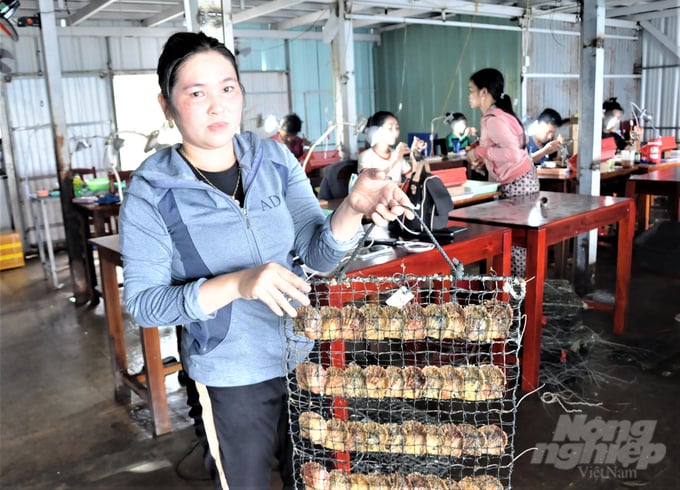
The pearl farming area owned by Ngoc Hien Phu Quoc Company is providing employment for numerous local workers, offering stable incomes. Photo: Trung Chanh.
According to Hoang Van Thanh, the 500-hectare mariculture farm currently employs over 70 workers responsible for various stages of production, including oyster breeding, pearl implantation, and oyster care until harvest. The workers enjoy a stable income ranging from 7 to 15 million VND per person per month, depending on the position.
The closed-loop technical process involves selecting healthy parent oysters from the wild and breeding them. Subsequently, the oysters are nurtured for approximately 12 months at sea. Aesthetically pleasing, large, and healthy oysters are selected for pearl implantation. The oysters are farmed for an additional 18 to 24 months (depending on the oyster species) before the pearls are harvested.
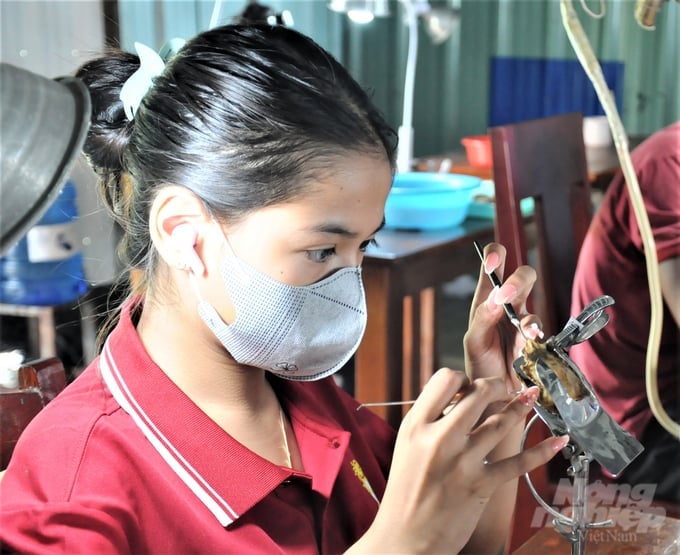
Technicians implanting pearl nuclei into oysters, before releasing them into the mariculture area until harvest. Photo: Trung Chanh.
Nguyen Trong Hien, Deputy Director of Aquaculture and Project Development at Ngoc Hien Phu Quoc, stated that the leasing of marine surface areas for pearl oyster farming not only brings high economic value, but also contributes to the restoration and protection of aquatic resources in association with sustainable marine economic development.
The company installed a system of anchors and boundary buoys within the farming area to mark the 500-hectare leased marine surface area. Accordingly, fishing vessels can navigate within this farming area without deploying nets. This restriction creates an ideal environment for various marine species to inhabit and reproduce.
Additionally, during the oyster farming process, parasitic species and barnacles often attach to the outer shell surface. Consequently, workers frequently use specialized high-pressure water jets in order to clean the oysters. This cleaning process also washes away organic and protein substances created by the parasites; thereby producing a food source for various species of shrimp and small fish.
Nguyen Trong Hien noted that pearl oysters are a mariculture species that require minimal feeding costs and help protect the water environment, due to their individual functionality as a mini water filter. Pearl products boast high economic value; create employment opportunities through pearl farming and product crafting in association with tourism and export; and contribute to the State budget.
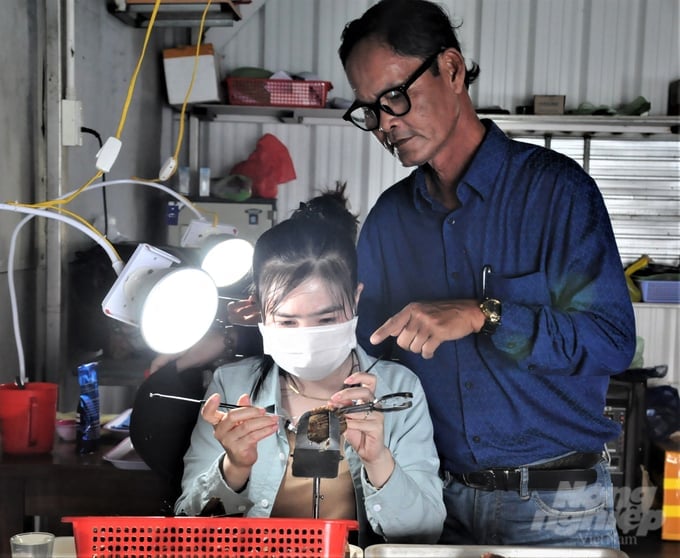
Nguyen Trong Hien providing instructions on the implantation of nuclei into oysters for pearl cultivation. Photo: Trung Chanh.
According to Deputy Director Hien, Ngoc Hien Phu Quoc has utilized the entirety of 500-hectare marine surface area for mariculture activities from 2020 to 2025. Additionally, the company followed a high-quality, closed-loop, and rotational farming process, with two harvests per year. As a result, the company harvests an average of 400 to 450 kilograms of pearls per year, which is equivalent to 450,000 standard pearls from two oyster species, Maxima and Akoya.
Moreover, Ngoc Hien Phu Quoc has mastered the technology for producing Maxima oyster (Pinctada maxima) seeds, with a capacity of 16 million seeds per year. The self-sufficient and closed-loop farming process involves seed production, oyster cultivation for implantation, and pearl oyster cultivation. Consequently, there is a significant demand for leasing marine surface areas.
After 2020, Ngoc Hien Phu Quoc planned to lease additional marine surface areas adjacent to the existing farm for the second phase of their project. The plan has received approval from the Ministry of Agriculture and Rural Development, the Directorate of Fisheries, and Kien Giang Provincial People’s Committee, allowing the company to expand their artificial pearl oyster farming area to 1,000 hectares.
The 9th Military Region Command has agreed to the company's expansion project, and conducted field surveys in order to confirm that the expanded mariculture area does not affect national defense and security tasks in Phu Quoc.
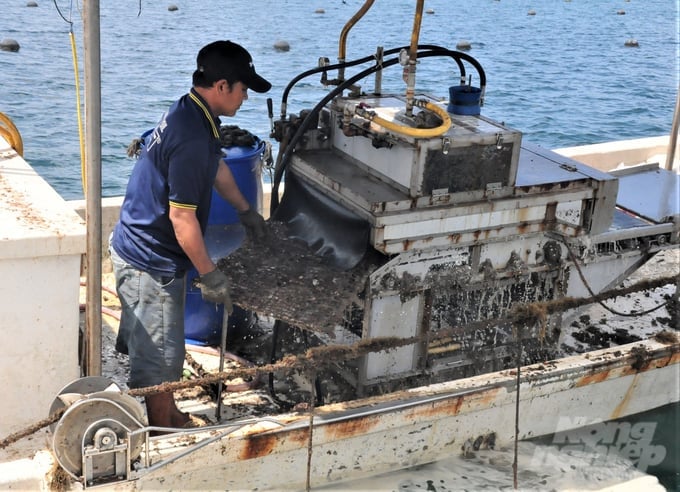
Oyster cleaning during mariculture helps wash away organic and protein substances created by parasites; thereby producing a food source for various small shrimp and fish species. Photo: Trung Chanh.
Ho Phi Thuy, Director of Ngoc Hien Phu Quoc, stated that the company plans to lease marine surface areas for the second phase of their project that spans from 2025 to 2030, with a vision extending to 2045. Accordingly, the company aims to fully utilize the 1,000-hectare marine surface area. After receiving approval from the local government of Kien Giang province to lease the additional marine surface area, the company plans to fully occupy the leased area with farmed pearl oysters. The plan includes releasing between 7 and 10 million oyster seeds per year, with an estimated annual production capacity ranging from 800 million to 1 billion pearls from Akoya, Maxima, and Tahiti oysters.
Ngoc Hien Phu Quoc's "High-Quality Pearl Farming" project employs advanced technology that is suitable for the local conditions, and capable of meeting all environmental and product quality standards. Pearl oyster farming will produce valuable jewelry, thereby promoting sustainable development of the pearl farming industry. The pearls cultivated in Phu Quoc's waters possess unique quality and characteristics, catering to both domestic and international tourists who visit this island city.

Ngoc Hien Phu Quoc is piloting the installation of concrete poles to transplant and restore coral reefs, with the aim of preserving biodiversity in Phu Quoc's waters. Photo: Trung Chanh.
Phu Quoc City People’s Committee has reviewed the project proposal for high-quality pearl farming by Ngoc Hien Phu Quoc, and authorized the City’s Economic Department to collaborate with Kien Giang province's Department of Agriculture and Rural Development for an on-site survey to consider permitting the expansion of the mariculture area.
The development of the mariculture project is expected to increase aquaculture yield and reduce the pressure caused by natural resource exploitation amidst declining aquatic resources. The farming targets, including pearl oysters and edible oysters, are filter feeders, which contribute to the improvement of seawater quality.
A representative from the Phu Quoc City People’s Committee remarked that Ngoc Hien Phu Quoc, with over 30 years of effective operations in Phu Quoc city, has created distinctive tourism products for visitors, demonstrated effective pearl farming models, and produced various pearl and oyster shell products. The company has provided stable employment for a large number of local workers, and actively contributed to social welfare and marine environmental protection. As a result, the company's request to expand the mariculture area is justified.
"Leasing marine surface areas for mariculture not only generates economic value but also contributes to the conservation of aquatic resources. The project includes research on the artificial breeding of Maxima oysters, which supports long-term production needs and helps balance the marine ecosystem in Phu Quoc city.
The company recently collaborated with the Vietnam National Institute of Oceanography and the Management Board of Phu Quoc Marine Protected Area to develop a project for the restoration and protection of aquatic resources, as well as the release of 45 million Maxima oyster seeds into the wild. Additionally, the company is piloting the installation of concrete poles to transplant and restore coral reefs, with the aim of preserving biodiversity in Phu Quoc's waters," shared Director Ho Phi Thuy.
Translated by Nguyen Hai Long
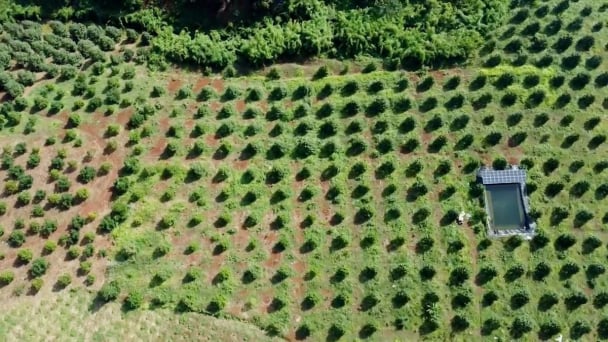
(VAN) Several scientists and farmers are experimenting with soil treatment in some key durian-growing regions such as Cai Lay (Tien Giang), Dak Song, Gia Nghia, and Dak R’lap (Dak Nong).
/2025/05/25/4127-3-073637_820.jpg)
(VAN) Thanks to the promotion from an FAO-implemented project, vegetable production in greenhouses in Moc Chau has seen strong development, from 1.5 hectares in 2021 to nearly 50 hectares in 2024.

(VAN) FAO has recently supported USD 140,000 to implement the project 'Risk mitigation human-animal interface risks through disease control initiatives in pig farming.'

(VAN) The People's Committee of Tra Vinh province has approved an adjustment to the investment policy for the Green Hydrogen Plant project, increasing its area to approximately 52.76 hectares.
![Reducing emissions from rice fields: [2] Farmers’ commitment to the soil](https://t.ex-cdn.com/nongnghiepmoitruong.vn/608w/files/news/2025/05/05/dsc08881jpg-nongnghiep-140632.jpg)
(VAN) Clean rice cultivation model in Thuong Tan commune, Bac Tan Uyen district, is assisting local residents in achieving sustainable agriculture by substantially reducing costs, increasing productivity, and protecting the environment.

(VAN) At the conference to disseminate Resolution No. 68, AgriS introduced its digital agricultural ecosystem and reaffirmed its commitment to accompanying the Government in promoting private sector development and sustainable agriculture.

(VAN) 'Blue Ocean - Blue Foods' initiative is designed to restore marine ecosystems and establish sustainable livelihoods for local communities by cultivating a minimum of 1,000 hectares of cottonii seaweed in the first three years.